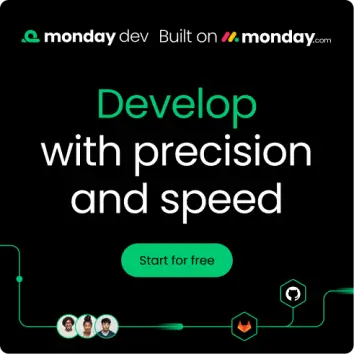Great products don’t happen in isolation. When development, marketing, and leadership operate in silos, even the best ideas fail to reach their potential. A structured product development process aligns every team on a shared plan — turning ideas into market-ready products that meet real customer needs.
This guide walks through the 8 essential stages of product development, from initial ideation to market launch. We’ll explore the key roles, methodologies, and metrics that successful teams use to ship products faster and with more confidence.
Try monday devKey takeaways
- Product development follows 8 essential stages from ideation to launch, giving teams a clear roadmap to transform ideas into successful products that customers actually want.
- Strong cross-functional collaboration between product managers, designers, engineers, and QA specialists is crucial for shipping quality products on time and avoiding costly delays.
- Choose the right methodology — Agile for flexibility, Stage-Gate for control, or Lean for efficiency — based on your product complexity and market requirements.
- Track meaningful metrics at each stage, from ideas validated during research to cycle time and team health, to continuously improve your development process.
- Flexible workflows, real-time visibility across teams, and AI-powered insights help you streamline your entire development process and make smarter decisions faster.
- A comprehensive product strategy managed within a platform like monday dev also ensures your team remains aligned throughout the entire process.
What is product development?
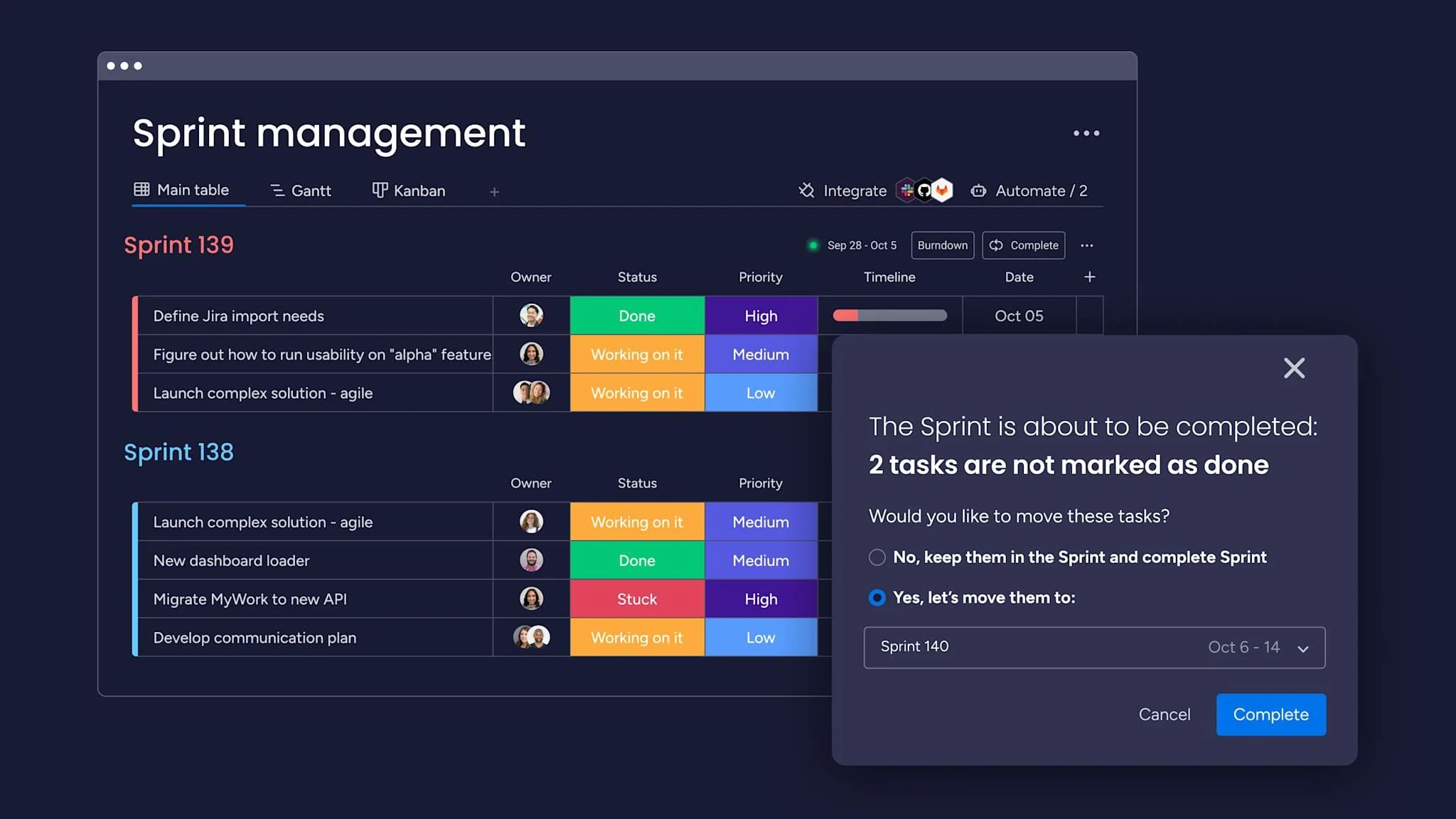
Product development is the complete process of bringing a new product from idea to market launch. This means taking a concept, validating it with customers, building it, and releasing it to solve real problems.
Think of it as a journey that transforms creative ideas into actual products people can buy and use. Whether you’re designing a physical product or building a SaaS platform, the steps that take an idea to market follow the same proven framework.
Product development vs. product management
Product management and development overlap, but their focus and success metrics differ:
| Aspect | Product development | Product management |
|---|---|---|
| Focus | Building and launching products | Strategy and lifecycle oversight |
| Timeline | Project-based with clear endpoints | Ongoing throughout the product lifecycle |
| Key activities | Design, engineering, testing | Market research, prioritization, stakeholder alignment |
| Success metrics | On-time delivery, quality standards | Market adoption, customer satisfaction |
Both functions are essential to a successful product development process, ensuring that teams build the right product — and build it right.
The 8 essential stages of product development
Every successful product follows a structured path from concept to customer. While some teams might combine or adapt these stages, understanding each one helps you build products that actually succeed in the market.
Here’s a quick look at the 8 stages, but keep reading to see what happens at each stage — and how to manage them effectively.
| Stage | Focus | Key deliverables |
|---|---|---|
| 1. Ideation & opportunity discovery | Generate and explore new product ideas | Brainstorm list, early concept validation |
| 2. Market research & validation | Test product-market fit | Customer surveys, competitor analysis |
| 3. Product planning & definition | Translate ideas into actionable plans | PRD, user stories, MVP scope |
| 4. Prototyping & MVP creation | Build minimal version for feedback | Low-fi mockups, MVP |
| 5. Design & user experience | Optimize usability and aesthetics | UI mockups, UX flow |
| 6. Development & engineering | Turn designs into working products | Sprint backlog, code base |
| 7. Testing & quality assurance | Ensure functionality and reliability | QA reports, bug fixes |
| 8. Launch & market introduction | Release and promote product | Launch plan, analytics setup |
Step 1: Ideation and opportunity discovery
Ideation is where you generate and explore new product ideas. This stage focuses on identifying problems worth solving and opportunities worth pursuing. Product discovery methods help refine and validate early concepts.
Start by looking at customer complaints, market gaps, or emerging trends. The best ideas often come from observing what frustrates people in their daily lives. Here’s where teams typically find inspiration:
- Customer feedback: Direct complaints or feature requests from current users
- Market gaps: Problems competitors haven’t solved well
- Technology trends: New capabilities that enable fresh solutions
- Internal brainstorming: Team insights based on industry experience
Stage 2: Market research and validation
Market research proves whether your idea has real potential. This stage saves you from building something nobody wants. It also helps clarify product differentiation by identifying unique value propositions early.
Gather evidence through surveys, interviews, and competitive analysis. The goal? Confirm that customers will actually pay for your solution.
Stage 3: Product planning and definition
Product planning turns your validated idea into a concrete plan. Here you’ll define exactly what you’re building and for whom.
Create a product requirements document that outlines features, user stories, and success metrics. Decide what goes in your minimum viable product (MVP) versus what can wait for later versions.
Stage 4: Prototyping and MVP creation
Prototyping brings your concept to life without full development costs. Start with simple sketches, then build increasingly realistic versions.
Your MVP in project management should include just enough features to solve the core problem and gather user feedback. Remember: You’re testing whether customers find value, not building the perfect product yet.
Example: Before Dropbox launched publicly, its MVP was a simple explainer video that validated demand before development.
Stage 5: Design and user experience
Design makes your product both beautiful and usable. This stage balances how things look with how they work. Focusing on product innovation at this stage can also give your design a competitive edge.
Focus on creating intuitive interfaces that guide users naturally through your product. Consider accessibility from the start to ensure everyone can use what you’re building. Good design reduces support requests and increases customer satisfaction.
Stage 6: Development and engineering
Development transforms designs into working products. Engineers build the technical foundation while maintaining close collaboration with designers and product managers.
Teams using monday dev can track sprint progress, manage bugs, and coordinate releases without switching between multiple platforms. This visibility keeps everyone aligned on priorities and deadlines.
Stage 7: Testing and quality assurance
Testing ensures your product works reliably before customers see it — catching issues that could frustrate users or damage your reputation. Tools like a Kano model template can help evaluate feature satisfaction during testing.
Run different types of tests throughout development:
- Functional testing: Does each feature work as intended?
- Performance testing: Can the product handle expected usage levels?
- Security testing: Are user data and systems protected?
- User acceptance testing: Do real users find it valuable and easy to use?
Stage 8: Launch and market introduction
Launch coordinates all the activities needed to introduce your product successfully. This includes marketing campaigns, sales training, and customer support preparation.
Plan both pre-launch activities (building awareness) and post-launch monitoring (tracking adoption) in your product plan. Be ready to iterate quickly based on initial customer feedback.
Try monday devBuilding your product development team
Great products come from great teams. Success requires bringing together people with different skills who can collaborate effectively toward shared goals. That means building a strong development team early on.
Essential roles and responsibilities
- Product manager: Owns the vision and product roadmap , translating business goals into product requirements
- Designer: Creates user experiences that balance aesthetics with functionality
- Engineer: Builds the technical product and ensures it scales reliably
- QA specialist: Tests thoroughly to catch issues before customers do
- Project manager: Keeps timelines on track and coordinates resources
Smaller teams might have people wearing multiple hats. What matters is covering all essential functions, not having perfect role separation.
Cross-functional collaboration
Effective collaboration makes the difference between smooth delivery and constant friction. According to a 2023 Gartner survey, 78% of leaders report “collaboration drag” — too many meetings and unclear decisions.
Effective teams establish clear communication patterns and shared visibility into work. Regular standups keep everyone aligned on daily priorities. Shared documentation prevents knowledge silos. monday dev provides the connective tissue, letting different functions see how their work impacts others.
Try monday devProduct development methodologies
Different approaches to product development suit different situations. Choose based on your market dynamics, team structure, and product complexity.
Agile product development
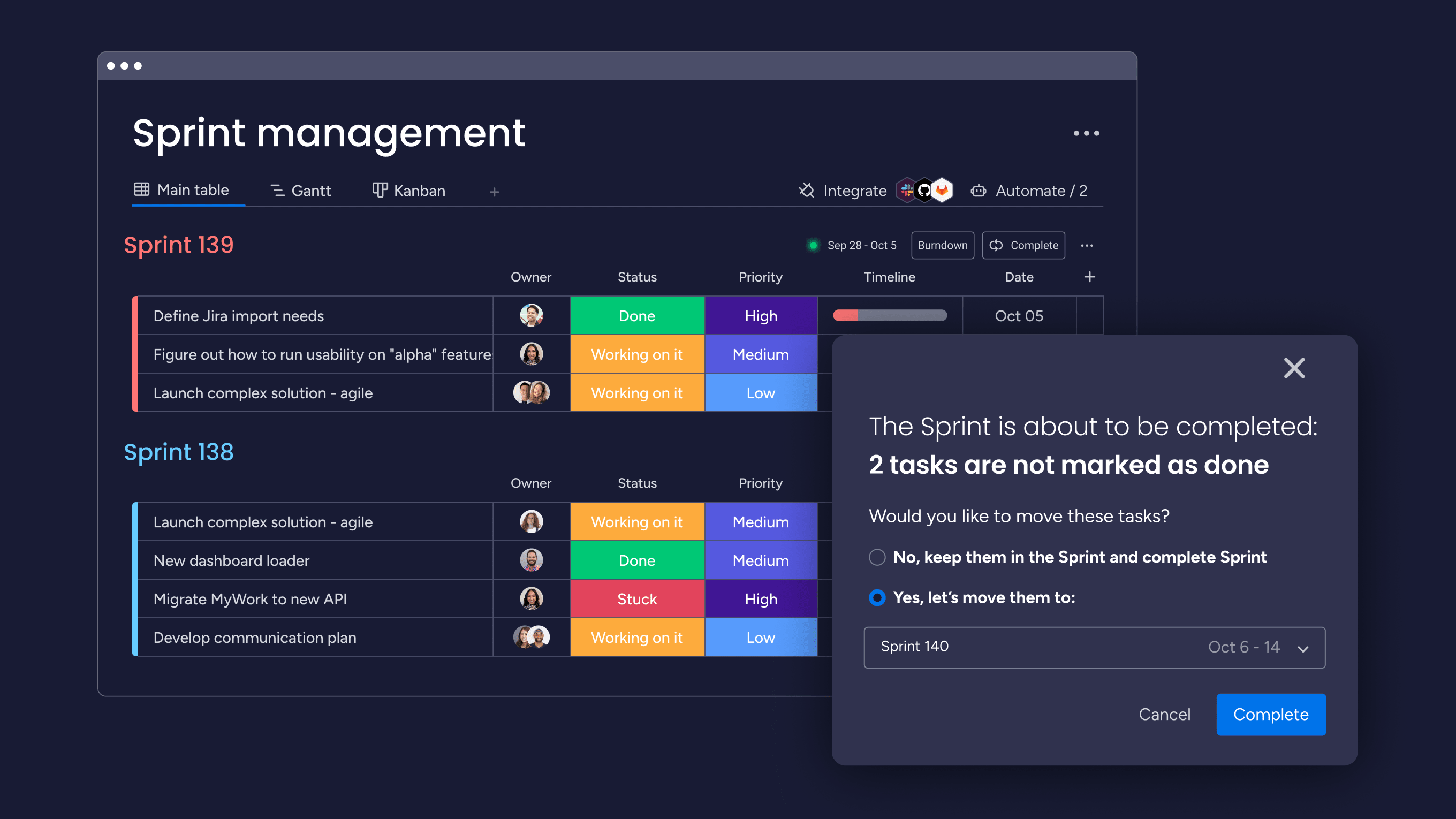
Agile breaks development into short sprints with regular customer feedback loops. Teams deliver working features every 1-4 weeks rather than waiting months for a big release. In some cases, rapid application development can speed up the feedback loop even further.
This approach excels when requirements might change or when you need rapid market feedback. Most software teams now use some form of Agile SDLC because it reduces risk and accelerates learning. According to a 2023 McKinsey report, companies adopting Agile practices have reduced time to market by 20 to 50% and improved productivity by 20 to 30%.
Stage-Gate process
Stage-Gate adds formal checkpoints between development phases. Teams must meet specific criteria before moving forward, providing more control and predictability.
This structured approach works well for products with high development costs or regulatory requirements. Think medical devices or automotive components where mistakes are expensive.
Lean product development
Lean focuses on eliminating waste and validating assumptions quickly. Build only what customers actually want, not what you think they want.
The build-measure-learn cycle helps teams test ideas cheaply before major investment. Many teams combine Lean thinking with Agile execution for maximum effectiveness.
Measuring product development success
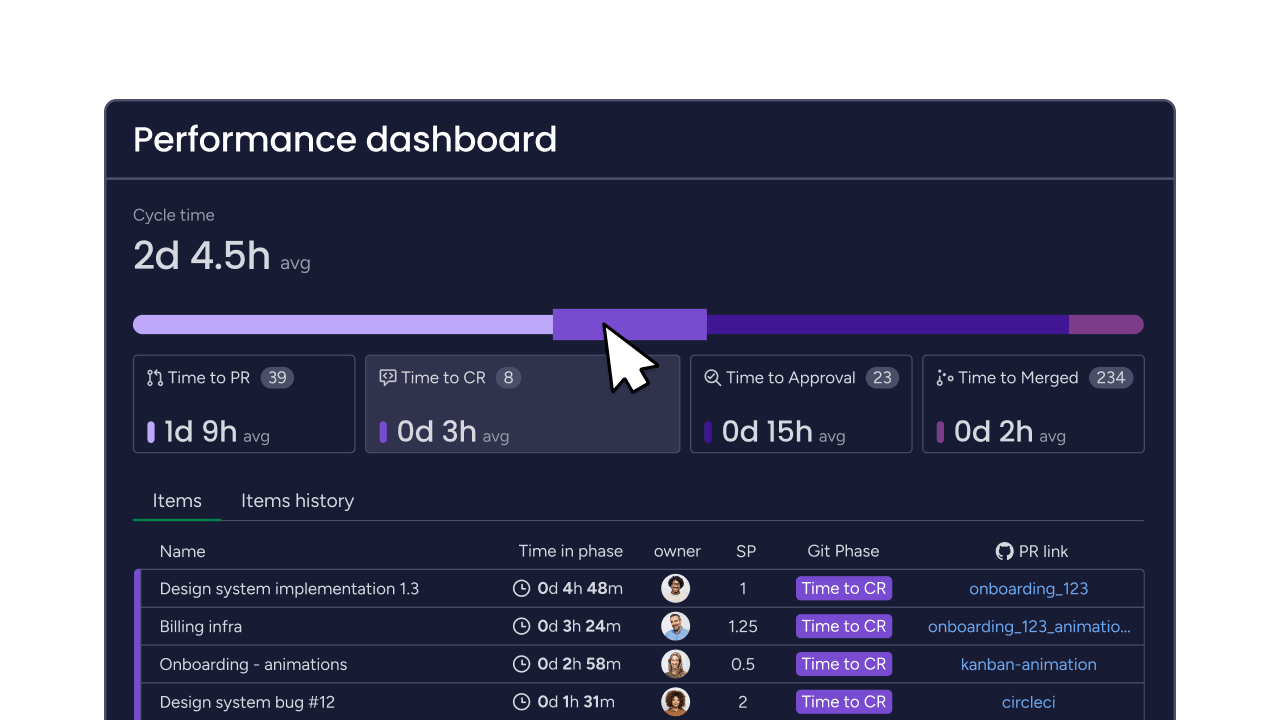
What gets measured gets managed. Track both how well your process works and whether your product achieves its goals, especially since, according to the monday.com 2024 World of Work Report, employees who understand how success is measured are 2x more likely to feel motivated.
KPIs for each stage
- Ideation: Ideas generated, concepts validated, time to first prototype
- Development: Sprint velocity, bug rates, feature completion
- Launch: Time to market, initial adoption, customer feedback scores
Overall process metrics
- Cycle time: How long from idea to customer value?
- Resource efficiency: Are you delivering maximum impact with available resources?
- Quality indicators: Do products meet standards without excessive rework?
- Team health: Is your team engaged and improving over time?
How monday dev accelerates your product development
Product development challenges often stem from coordination problems, not technical ones, which can also affect product lifecycle management. These fundamental issues require purpose-built product development software designed specifically for development teams — which is exactly what monday dev delivers.
Streamline every stage with flexible workflows
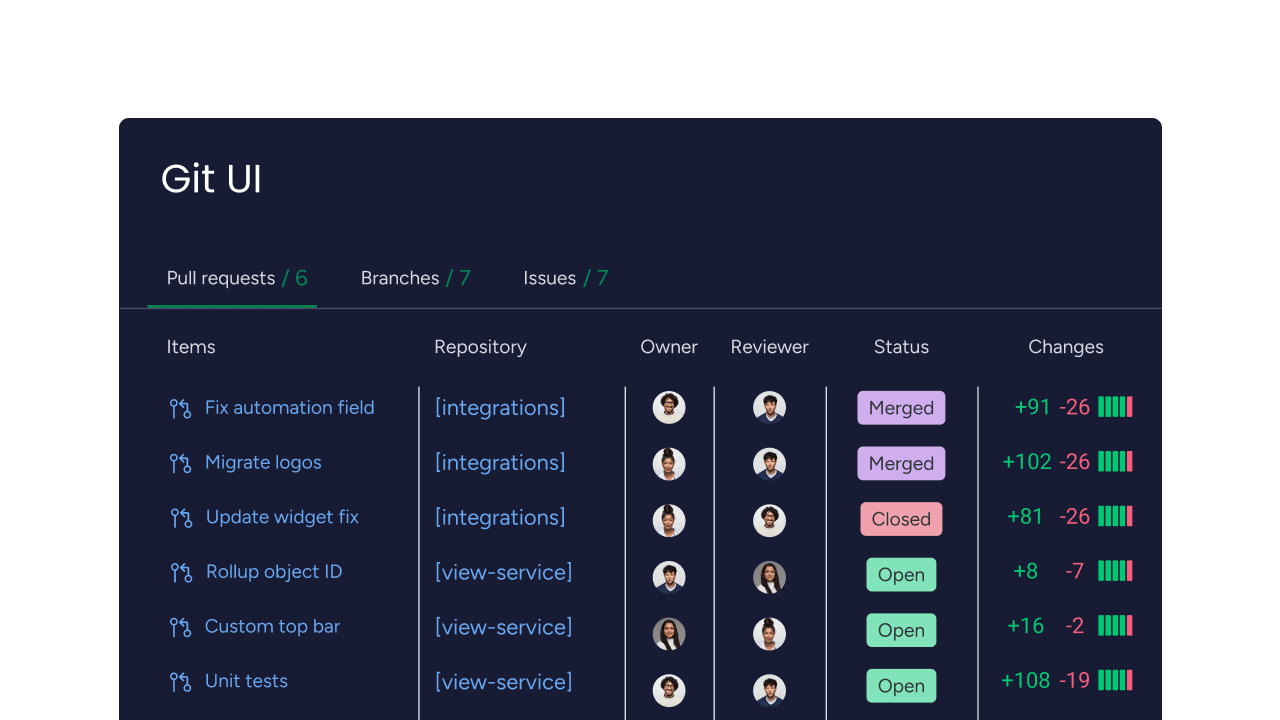
Every team works differently, and monday dev adapts to your process rather than forcing you into a rigid framework.
Create custom workflows that match how you actually work. Use pre-built templates for common processes like sprint planning or bug tracking. Leverage our Git integration to sync code commits automatically, and connect Jira, Figma, and 100+ other tools through our robust API. Set up automations that notify teams when tasks move between stages, eliminating manual handoffs.
Enable real-time cross-team visibility
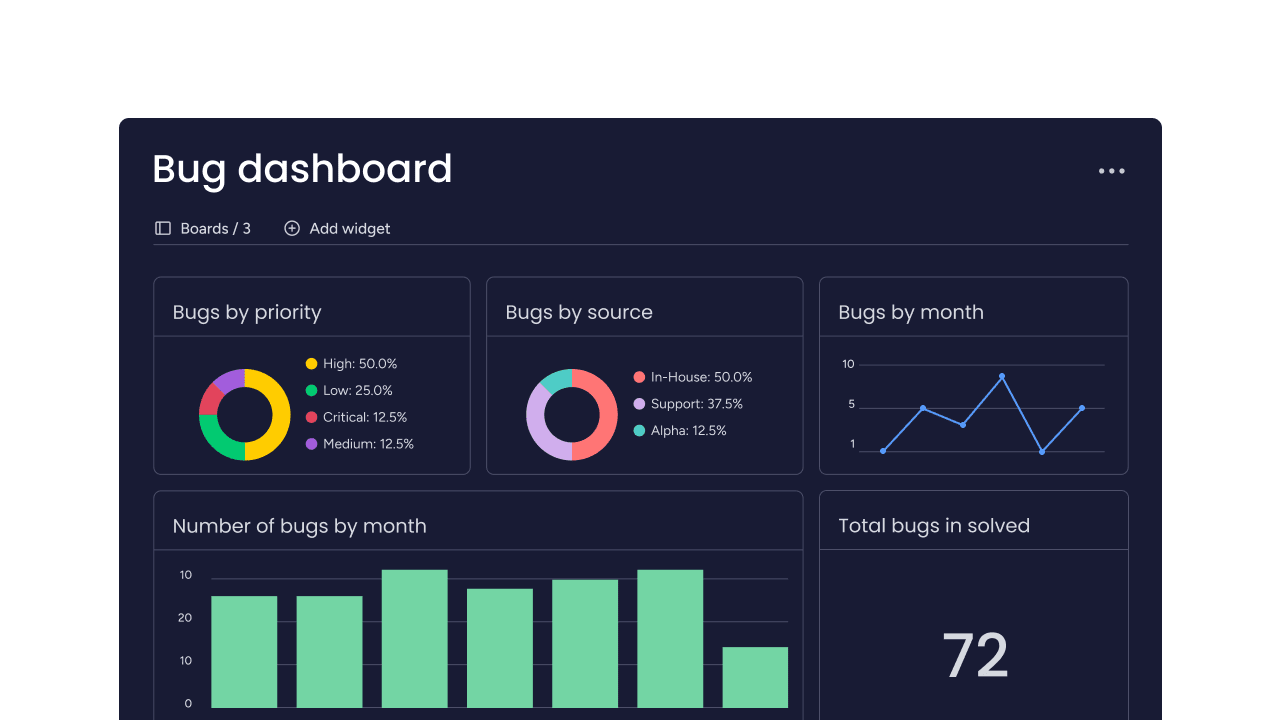
Can your CEO see current sprint progress? Can designers know when developers need final assets? Visibility gaps create delays and frustration, a problem highlighted by the fact that only 61% of employees in large enterprises are satisfied with transparency in their organization.
With customizable dashboards that show exactly what each stakeholder needs, monday dev ensures engineers see technical details in Kanban boards while executives get high-level burndown charts and development velocity metrics — all from the same underlying data.
Our roadmap view connects strategic initiatives to daily tasks, helping everyone understand how their work contributes to larger goals.
Leverage AI for smarter development decisions
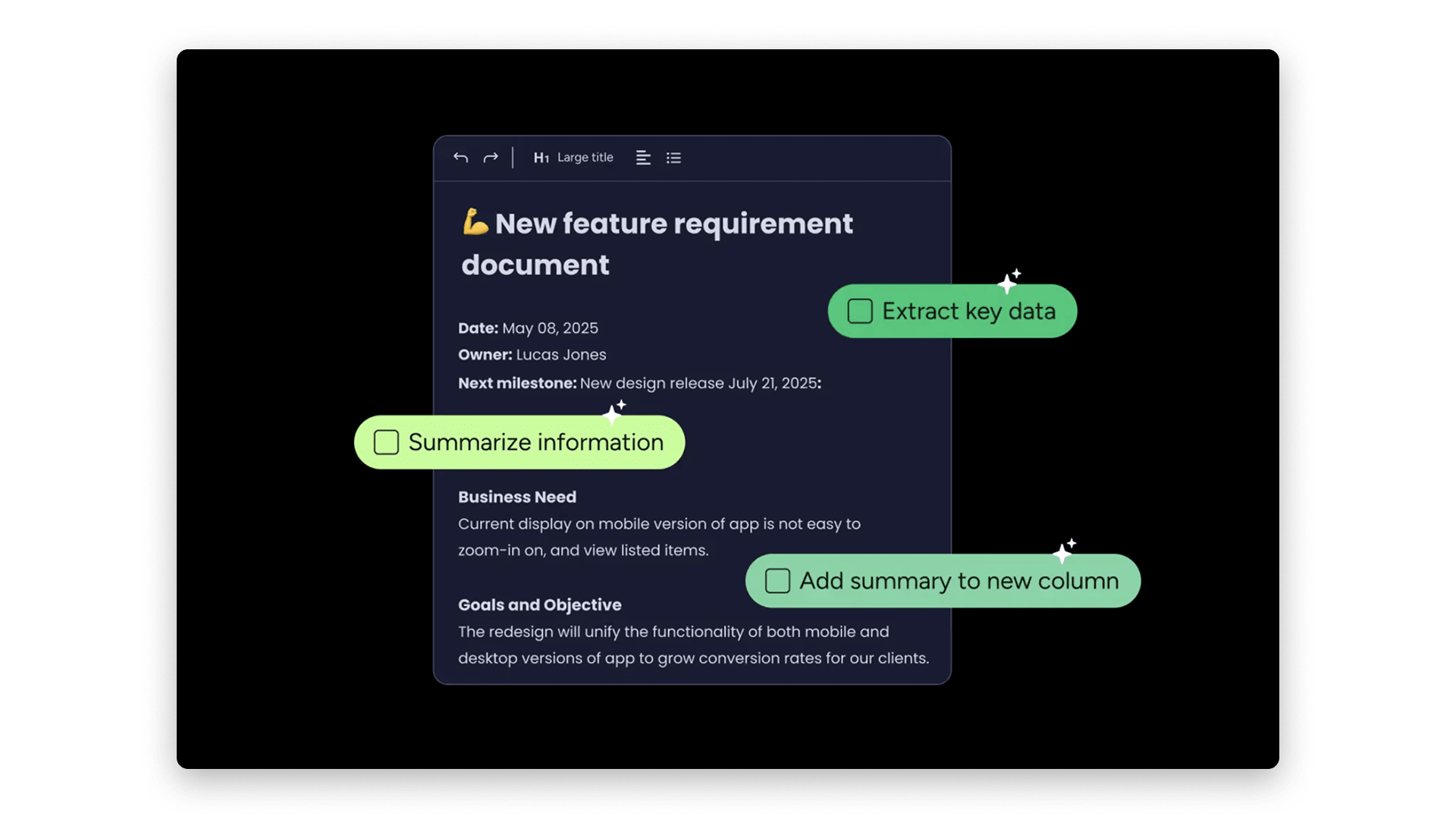
AI capabilities in monday dev help teams work smarter, not just harder. From automating repetitive work to predicting risks, our built-in AI assists at every stage of the product development process:
Generate user stories and test cases automatically: Draft stories from requirements and build test cases based on acceptance criteria.
Summarize sprint retrospectives into actionable insights: Quickly capture lessons learned and next steps.
Predict and prevent project delays: Use predictive analytics to flag potential blockers before they impact delivery.
Balance team workloads intelligently: Our AI recommends task reassignments when workloads are uneven.
Prioritize bugs by impact and effort: The intelligent bug engine cuts down manual triage time.
Identify risks early: Historical pattern analysis alerts you when projects start to drift off course.
Improve code quality automatically: The AI-powered code review assistant suggests improvements before production.
Start building better products faster
Product development doesn’t have to mean endless meetings, missed deadlines, and disconnected teams. With the right process and tools, you can ship products that customers love while keeping your team aligned and motivated.
Whether you’re building your first MVP or managing a complex product portfolio, monday dev platform keeps everyone on the same page from ideation to launch. Start your free trial today and see how monday dev can accelerate your development process.
Try monday devFAQs
What are the 7 stages of a new product development process?
The 7 stages of the new product development process are idea generation, idea screening, concept development and testing, marketing strategy development, business analysis, product development, and market testing. Today, many teams expand this framework to 8 stages, separating design and engineering for clearer execution and feedback loops.
What are the 5 phases of product development?
The 5 phases are concept development, planning, design and prototyping, development and testing, and launch. This simplified framework works best for small projects or startups that need to move quickly.
What are the 8 stages of new product development?
The 8 stages are ideation and opportunity discovery, market research and validation, product planning and definition, prototyping and MVP creation, design and user experience, development and engineering, testing and quality assurance, and launch and market introduction. This comprehensive approach ensures teams validate ideas early and maintain momentum through launch.
What are the 4 Ps of product development?
The 4 Ps — product, price, place, and promotion — belong to marketing strategy rather than the product development process itself. Still, development teams should consider how design, features, and pricing choices will impact each “P” to ensure a successful market launch.
How long does the typical product development process take?
Most product development processes take 6 months to 2 years, depending on complexity. Software products often launch early versions within 3–12 months, while physical products typically need 12–24 months due to manufacturing and regulatory steps.
What is the difference between product development and new product development?
Product development includes both creating new products and improving existing ones through updates or feature enhancements. New product development (NPD) focuses specifically on bringing entirely new products to market for the first time.
 Get started
Get started 


